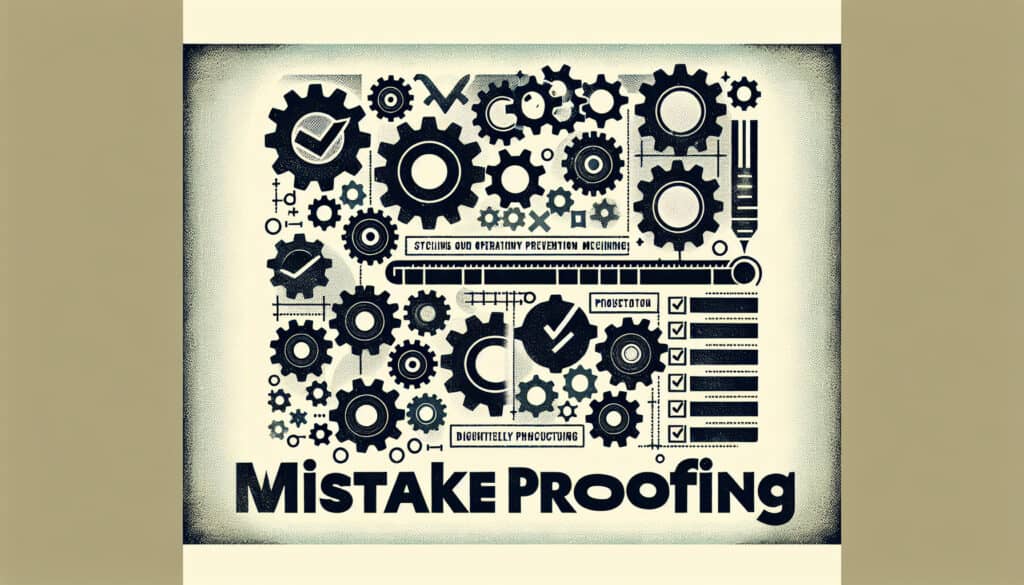To prevent errors from occurring in a process.
- Methodologien: Lean Sigma, Herstellung, Qualität
Fehlervermeidung (Poka-Yoke)

Fehlervermeidung (Poka-Yoke)
- Kontinuierliche Verbesserung, Design für die Fertigung (DfM), Fehlervermeidung, Schlanke Fertigung, Poka-yoke, Prozessverbesserung, Qualitätssicherung, Qualitätskontrolle, Sechs Sigma
Zielsetzung:
Wie es verwendet wird:
- A Japanese term that means 'mistake-proofing'. It is a technique for preventing errors by designing processes and products in a way that makes it impossible for errors to occur. For example, a USB plug can only be inserted in one direction.
Vorteile
- Prevents errors from occurring, which improves quality and safety; Can reduce costs and improve efficiency.
Nachteile
- Can be difficult to implement for all types of errors; May not be a substitute for training and supervision.
Kategorien:
- Lean Sigma, Herstellung, Qualität
Am besten geeignet für:
- Designing products and processes in a way that prevents errors from occurring, such as in a manufacturing assembly line.
Poka-Yoke techniques can be applied in various sectors such as automotive manufacturing, healthcare, electronics, and food processing, where minimizing errors is paramount. During the design phase, engineers and designers collaborate to identify potential failure points within a process or product, enabling the implementation of fail-safe mechanisms before production begins. For instance, in a manufacturing assembly line, fixtures can be designed to guide components into correct positions, while in software development, user interfaces can include prompts that prevent data entry errors. Quality control teams often integrate Poka-Yoke principles to enhance inspection processes by employing checklists or automated systems that flag inconsistencies. This methodology can be initiated by project managers or quality engineering teams, encouraging involvement from cross-functional teams including production workers who can provide insights on practical challenges faced on the shop floor. Industries such as healthcare utilize Poka-Yoke through medication dispensing systems that ensure patients receive the correct dosage, emphasizing patient safety and operational efficiency. The implementation of these techniques not only enhances quality but also leads to significant cost savings, as the expenses associated with rework, waste, and customer complaints diminish. By embedding error-prevention measures directly into processes, organizations cultivate a culture of continuous improvement, reinforcing accountability among employees while fostering operational reliability.
Die wichtigsten Schritte dieser Methodik
- Identify potential failure modes in processes or products.
- Evaluate the impact and frequency of identified failure modes.
- Develop solutions that eliminate or reduce the likelihood of errors occurring.
- Implement Poka-Yoke devices or methods in the design process.
- Test the effectiveness of the implemented solutions under real conditions.
- Iterate on the design based on feedback and error occurrence rates.
- Educate users about the Poka-Yoke features in the design.
- Establish a monitoring system for ongoing error detection and prevention.
Profi-Tipps
- Integrate error detection sensors in assembly lines to provide immediate feedback on incorrect part positioning or insertion to prevent defects.
- Design interchangeable components that can only fit in one way or are distinguishable by tactile cues, reducing the risk of assembly errors.
- Implement standardized work processes with visual aids and limits on part usage to curb mistakes during repetitive tasks on the manufacturing floor.
Verschiedene Methoden lesen und vergleichen, Wir empfehlen die
> Umfassendes Methoden-Repository <
zusammen mit den über 400 anderen Methoden.
Ihre Kommentare zu dieser Methodik oder zusätzliche Informationen sind willkommen auf der Kommentarbereich unten ↓ , sowie alle ingenieursbezogenen Ideen oder Links.
Historischer Kontext
1950
1950
1950
1960
1960
1960
1960
1950
1950
1950
1958
1960
1960
1960
1960
(wenn das Datum nicht bekannt oder nicht relevant ist, z. B. "Strömungsmechanik", wird eine gerundete Schätzung des bemerkenswerten Erscheinens angegeben)















Verwandte Artikel
Meta-Analyse
Nachrichten-Mapping
Mentalmodell-Diagramme
Maximal zulässige Druck- und Zugkräfte
Materialbedarfsplanung (MRP)
Master Production Schedule (MPS)